My leaning Cussonia gamtoosensis took a serious dive earthward in late August. Like a watched pot that never boils, it’s difficult to discern when a chronically leaning tree is in imminent danger of failing, but clearly the cabbage palm was on the move earthward. Hoping drastic surgery might save the tree, one of its three branches was removed, the one leaning most northward, in an attempt to lighten the canopy. A sawhorse was positioned just forward of the trunk for insurance. In just a few days, the tree was leaning entirely on the sawhorse for support. There was no denying that the pot had finally boiled over. For a day or so I thought about leaving the sawhorse as a permanent support — this tree is so stunning that even with an ugly sawhorse holding it up it still had beauty to spare, but all the planting around it looked cheapened, and there was the safety of nearby Grevillea ‘Moonlight’ and the ‘Hercules’ aloidendron/aloe to consider. Checking the tree’s roots, a vast network of soil-less pockets was discovered, either a consequence of the tree slowly uprooting or the soil-displacing activities of ants. Whatever the cause of the tree’s failure to remain upright, it was time.
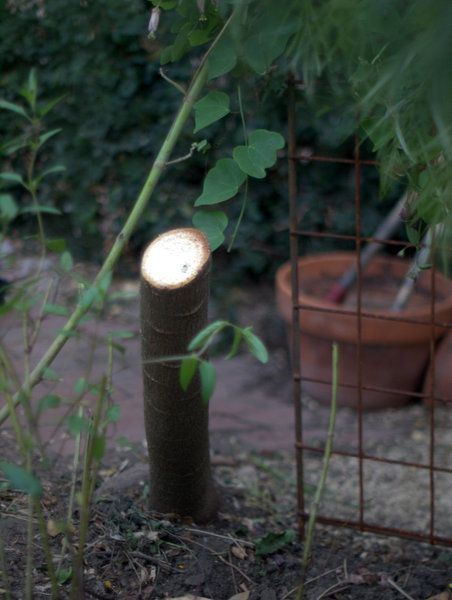
An appropriate name for the garden now might be “The Stumpery” — the massive stump of the smoke tree ‘Grace’ is still here since the tree’s removal in August 2012, now propping up a foxtail agave, Eucalyptus ‘Moon Lagoon’ has not been fully cut down even though new growth from the base has long since died, and now the cussonia, all of which comes from being something of an incorrigible risk taker as far as experimenting with plants. Will I ever change? Probably not, as long as there’s strength left to deal with the consequences of an indiscriminate appetite for plants (see “ghosts of gardens past.”) Of course, the dog days of August had nothing to do with the loss of the unstable cussonia, but the heat did take out quite a few first-year introductions lacking the root system to withstand the stress, including two leucospermums.
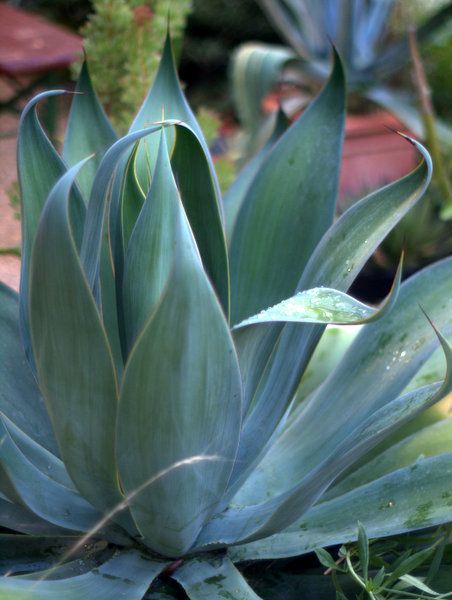
But well-established plants have amazing resistance to extreme heat. Check out the defensive posture of Agave ‘Blue Flame.’
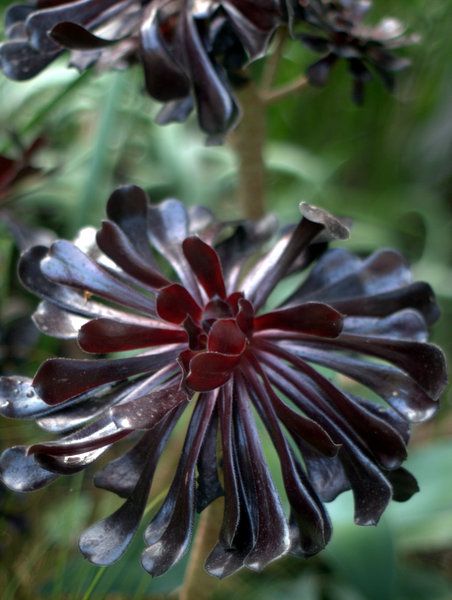
‘Zwartkop’ also protectively curled in on itself. (Not all aeoniums are created equal as far as summer dormancy goes. ‘Zwartkop’ doesn’t get too shabby, nor the variegated ‘Sunburst,’ whereas ‘Goliath’ is abysmal, losing most of its leaves.)
But the loss of the cussonia set in motion a day of furious digging and plant shifting. It is ever thus: first comes the heartbreak, then the cold calculation of new opportunities, the ongoing saga of creative destruction in the garden. Now I had a prime spot for Melianthus ‘Purple Haze,’ which has always hated dealing with full afternoon sun all summer. With the cussonia gone, the bog sage cut back, Rudbeckia triloba pulled, the melianthus could be settled into a dappled sun/afternoon shade location adjacent to Grevillea ‘Moonlight,’ which needed a bit of straightening after the pushing and shoving it endured from the cussonia. Time will tell if the melianthus appreciates being dug, split, and moved during the warm days of early September. All I can say is that the hot weather combined with losing the cussonia put me in a bit of a ruthless mood.
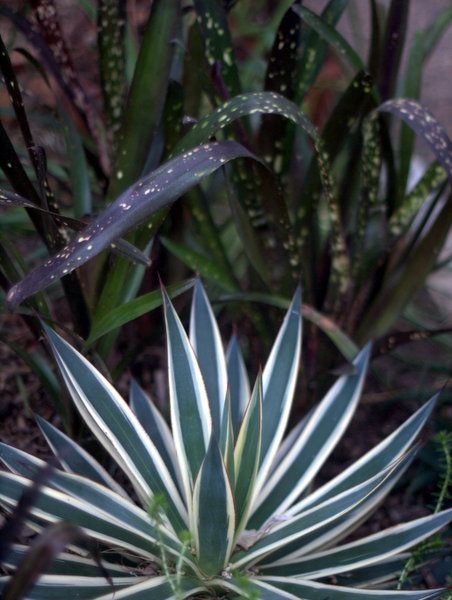
But it’s always good to shake things up and get a fresh look. Agave ‘Snow Glow’ shines even more backed by a chorus of the bromeliad Bilbergia ‘Hallelujah’ which were uprooted in the upheaval.
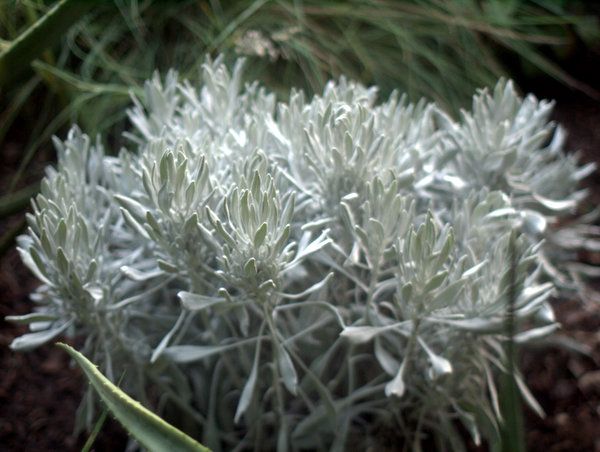
In the full-sun vacancy left by the melianthus was an opening to try Senecio palmeri, endemic to searingly hot and dry Guadalupe Island off Baja California. I’ve had an eye on this one at the local nursery all summer. Goats were introduced to the island by whalers not long after it was first identified, so there’s very little of it left on the island.
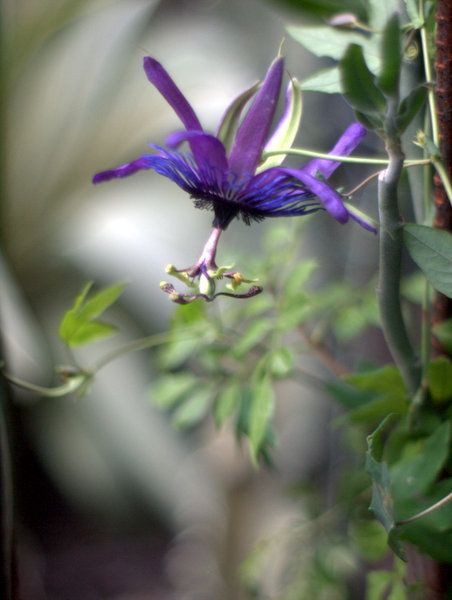
Looking for Senecio palmeri at the nurseries, I fell under the spell of Passiflora ‘Witchcraft.’ Reputed to bloom only in late summer/fall, with leaves that burn in too much sun but flowering poorly in too little sun, i.e., troublesome, it has The Stumpery’s name all over it. (“Wicked witchcraft, and although I know it’s strictly taboo, when you arouse the need in me, my heart says yes, indeed in me, proceed with what you’re leading me to,” etc.)
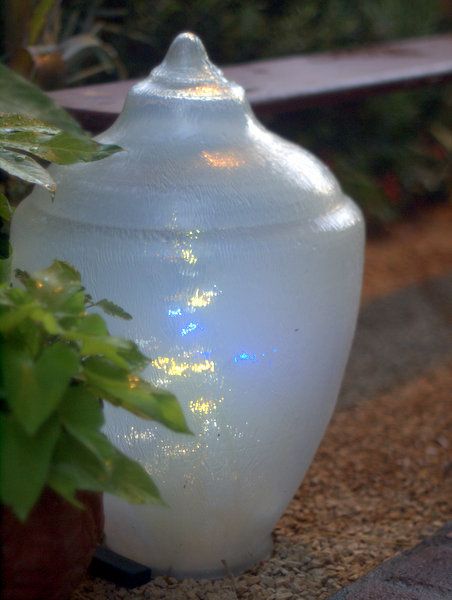
More sparkly lights seemed appropriate after the dog days of August. In this season of unusually fierce storms, wishing you a safe weekend.

Ugh. I’m so sorry about the cussonia. What you’ve planned and will do to make up for it sounds enchanting, but that’s a heartbreaker. When they’re vigorous (or, in this case, seemingly overly vigorous) there is nothing that outcompetes them. Are you leaving the stump, then?
Sorry about losing the Cussonia. I hope all the plants you moved thrive for you. I don’t need dying plants to get a bee in my bonnet about making changes, but when I get a brainwave I go out and start buying plants to put my plan in motion, and then of course I have to keep them alive while I wait to implement. Not the smartest move, of course, but if I wait until weather cools off and the rains return here, there will be nothing at the nurseries to buy.
The damn heat-we had a very pleasant summer until about 2 or three weeks ago when typical August set in. I really think I could just skip that month altogether. I mourn the loss of your beautiful Cussonia. I had one in a pot that upped and died this summer for reason that remain mysterious. I will acquire another.. I have to kill a plant way more than once before I give up on it. A will I ever find Snow Glow ?
Condolences on the loss of your beautiful Cussonia, Denise. Getting busy with clean-up and rearrangement is usually the best way to adapt to a plant loss in my view. My Leucadendron ‘Pisa’ has been giving me concern. It’s top-heavy and, since last Sunday’s wild thunderstorm, some branches have failed to straighten even after light pruning to remove some of the foliage weight. I think I probably need to bite the bullet and give it a serious pruning before the next bout with wind corrects the problem for me – I’m not ready for a stumpery!
Sorry for your Cussonia. But I had to laugh at the quick transition from heartbreak to cold calculation of new possibilities. I’ve had my eye on a snakebark maple in my garden for most of a year. It looks perfectly healthy, except that it didn’t put out the second flush of leaves it normally does, save on a couple branches, and it has two large patches of dead bark at the base of the trunk. I think it’s phytophthora. I’ve already planned to replace it with a clumping bamboo, which helped to trigger plans for a bamboo takeover of the garden. Then a young embothrium started declining in the heat, leaving another hole to fill with bamboo.
Hope your risks pay off!
I greatly admire your moxie in moving plants so readily–I haven’t been able to do that yet. And, I enjoyed heading over to your “ghosts of gardens past” link, to see where you’ve been. All such beautiful stages!
@Saurs, I think I’ll leave the stump for now. It’s small, and removal might disturb the grevillea.
@Allison, I have two modes of acquiring plants. The first mode I’m in pretty much all the time, if I see something interesting that can live in a pot. The second mode is when the garden opens up a gap — then I jump into overdrive! So glad your cooling off up there.
@Kathy, I’ll keep an eye out for Snow Glows. It’s a slow grower so would do well in a pot.
@Kris, say no to the stumpery! I have that little silver Leuc. meridianum that seems to have survived summer. I hope your Pisa straightens itself out!
@Evan, but isn’t that exciting, going from a maple to a bamboo? Such a different look, sound and mood. A garden is just a big batch of lemonade for all the lemons we keep getting, right?
@Holly, I love that word “moxie”! So glad you enjoyed the old photos.